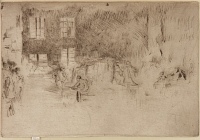Murano - Glass Furnace | ||
| Number: | 205 | |
| Date: | 1879/1880 | |
| Medium: | drypoint | |
| Size: | 161 x 238 mm | |
| Signed: | no | |
| Inscribed: | no | |
| Set/Publication: | no | |
| No. of States: | 4 | |
| Known impressions: | 7 | |
| Catalogues: | K.217; M.214; W.187 | |
| Impressions taken from this plate (7) | ||
KEYWORD
forge, furnace, glass-furnace, interior, nocturne, people, worker.
TITLE
Variations in the title and punctuation are as follows:
'Murano - Glass Furnace' (1883, Fine Art Society). 1
'Murano - Glass Furnace' (1886, Frederick Wedmore (1844-1921)). 2
'Murano Glass Furnace' (1889, Whistler). 3
'Murano - Glass blowers. Venice' (1890/1892, Beatrice Whistler (1857-1896)). 4
'Murano Glass Works' (1903/1935, possibly Rosalind Birnie Philip (1873-1958)). 5
'Glass-Furnace, Murano' (1909, Howard Mansfield (1849-1938)). 6
The original title, 'Murano - Glass Furnace' is preferred, although Beatrice Whistler's version, specifying the actual workers, is an interesting alternative.
'Murano - Glass Furnace' (1883, Fine Art Society). 1
'Murano - Glass Furnace' (1886, Frederick Wedmore (1844-1921)). 2
'Murano Glass Furnace' (1889, Whistler). 3
'Murano - Glass blowers. Venice' (1890/1892, Beatrice Whistler (1857-1896)). 4
'Murano Glass Works' (1903/1935, possibly Rosalind Birnie Philip (1873-1958)). 5
'Glass-Furnace, Murano' (1909, Howard Mansfield (1849-1938)). 6
The original title, 'Murano - Glass Furnace' is preferred, although Beatrice Whistler's version, specifying the actual workers, is an interesting alternative.
1: London FAS 1883 (cat. no.1).
2: Wedmore 1886 A[more] (cat. no. 187).
3: Whistler to Dowdeswell, 16 February 1889, GUW #13031.
4: List, GUW #12715.
5: Envelope containing the copper plate, University of Glasgow
6: Mansfield 1909[more] (cat. no. 214).
DESCRIPTION
In the centre of a two-storey workroom is a large furnace, with workmen around it. The glass-workers include a man standing with hands on hips behind the furnace at left; a man in front of the furnace, at left, bending over and balancing a rod in his hands; and two figures, leaning back at right, in a blaze of light from the furnace, who are probably glass-blowers. Groups of spectators stand in the foreground at left and distance to right of the furnace. To left, beyond the furnace, are open windows and a double doorway.
SITE

Glass furnace, Murano, 2005.
Photograph©M.F. MacDonald, Whistler Etchings Project.
The island of Murano in the Mediterranean, near Venice, Italy, is famous for its glass work. 7
Whistler apparently loved the subject but did not particularly like the glass. When he received a crystal flower from Robert de Montesquiou-Fezensac (1855-1921), he wrote:
Whistler apparently loved the subject but did not particularly like the glass. When he received a crystal flower from Robert de Montesquiou-Fezensac (1855-1921), he wrote:
7: Grieve 2000[more], pp.72, 175.
'Non! ces verres là ne se font plus à Murano! -
/ Voilà trois siècles qu'ils ont oublié la simplicité joyeuse, la légereté grave, et le caprice d'imagination necessaire pour produire le petit chef d'oeuvre que vous nous envoyez de Paris'. 8
(Translated: 'No! those glasses are no longer made in Murano! - It is three centuries since they forgot the joyous simplicity, the light solemnity, and the flight of imagination necessary to produce the little masterpiece which you send us from Paris').
(Translated: 'No! those glasses are no longer made in Murano! - It is three centuries since they forgot the joyous simplicity, the light solemnity, and the flight of imagination necessary to produce the little masterpiece which you send us from Paris').
Curiously, Murano - Glass Furnace was among works that the artist may have been printing and was certainly selling at the time he wrote to Montesquiou denying the artistry - if not the craftsmanship - of their work.
DISCUSSION
Forges, furnaces and smiths are a recurrent subject in Whistler's work: the forge provided a warm place to work, and possibilities for dramatic lighting and complex figure compositions. These include several etchings (The Forge 086, Nocturne: Furnace 208, The Smithy 239, Wheelwright 240 and Flaming Forge 490); an oil painting,
The Little Forge, Lyme Regis y442; a number of lithographs (The Tyresmith c036, The Whitesmiths, Impasse des Carmélites c092, The Forge, Passage du Dragon c102, The Smith, Passage du Dragon c103,
The Master Smith c120,
The Sunny Smithy c121,
The Good Shoe c122,
Father and Son c123,
The Strong Arm c125,
The Blacksmith c127 and The Brothers c128); and some related drawings. 9
9: Study for 'The Little Forge' (K.147) m0574, Sketch of 'The Whitesmiths, Impasse des Carmélites' m1417, Sketches of 'The Forge: Passage du Dragon' and 'The Smith: Passage du Dragon' m1450, r.: The Blacksmith's, Howth; v.: Horse in a stable m1619, r.: The Forge; v.: Smiths, Ajaccio m1679, The Flaming Forge, Ajaccio m1678.
